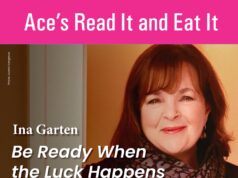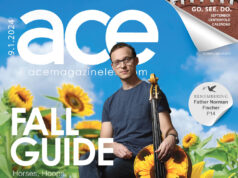
Don’t Call it a Memoir:
Punk luminary Richard Hell remembers his Lexington childhood in new autobiography
[three_fifth]
EXCERPTED FROM “I Dreamed I was a Very Clean Tramp: An Autobiography,” by Richard Hell
“We lived in the suburbs in America in the fifties. My roots are shallow. I’m a little jealous of people with strong ethnic and cultural roots. Lucky Martin Scorsese or Art Spiegelman or Dave Chappelle. I came from Hopalong Cassidy and Bugs Bunny and first grade at ordinary Maxwell Elementary.

In the center of town stood a classic rough-hewn Romanesque courthouse, with an equestrian statue of Confederate general John Hunt Morgan out front. A few blocks further along Main Street lay the train station waiting shed, and in that same stretch Main’s two cozy, plush movie houses, the Kentucky and the Strand, which were staffed with pimpled ushers and showed first-run double features and cartoons, including Saturday-morning all-cartoon programs. By the bus stop there was a Woolworth’s dime store and a bakery that sold glazed doughnuts warm from the oven.
The limestone, pillared public library was in the middle ofa heavily wooded park a few blocks behind the courthouse, across the street from Transylvania College (“the first college west of the Allegheny Mountains”). Inside, the library was marble, with sunshine from the second-story skylight brightening the ground floor’s central information desk; whispers, shuffling shoe steps, and shelves and shelves of musty-smelling, dimpled green or orange library-bound books free for the taking.
On the outskirts of town were drive-in movies and an amusement park. The family would take grocery bags full of homemade popcorn to the drive-in, and on the way home, my sister and I fit lengthwise, head to feet, in the backseat, asleep. Every once in a while we’d get to visit Joyland, where there was a wooden roller coaster and a merry-go-round and a funhouse and a Tilt-a-Whirl in the midst of game booths and cotton candy and hot dog stands among huge shade trees with picnic tables below them and starlings under those.
In the suburbs the houses were unlocked. There was no “air-conditioning” but fans. A big warehouse in a weathered industrial neighborhood towards town stocked fresh-cut blocks of ice yanked at a loading dock by giant tongs into newspapered car trunks to power iceboxes — though most people did own a refrigerator by then — or to fill coolers for picnics. You’d stab the slick crystal with picks till it cracked…
In the winter of 1956, when I was in first grade, the family moved from the cottage on Rose Street to a new suburb, Gardenside, on the other side of town.

Nearly every lot in the tract was the same small size and there were only a few house designs, mostly two-bedroom. Each house had saplings in the same two spots on either side of the walk leading up to the front door and the same type of evergreen shrubbery under the living room picture windows facing the street. Our house was just like the classic child’s drawing of a home, a red-brick box under a steep shingled roof that had a chimney on one end of it.
At the bottom of the street ran a creek. Lawns descended to border both sides of it, but along its banks uncut foliage grew thick and high. The most interesting thing about it was that it wasn’t man-made. The idea that you could follow its path rather than the patterns imposed by people on everything in sight was exciting. I remember first realizing that the creek might start and end anywhere, far off, that it didn’t just exist in the area I knew. The thought was a glowing little diorama hidden inside my brain, kind of like Duchamp’s Etant donnes (Given: 1. The Waterfall, 2. The Illuminating Gas).
Gardenside had farmland at its borders — tobacco and corn and livestock — and woods.
Our house was one of the first in the suburb to be completed, and the ongoing construction all around us for blocks was our playground.
This excerpt appears on page 14 of the April 11, 2013 print edition of Ace.
[/three_fifth]
[two_fifth_last]
Richard Hell
In a March 2013 Esquire Q and A with Richard Hell, writer Scott Martelle introduces him by saying,
“It’s hard to pick one grandfather of punk, but at least as much of Richard Hell’s DNA courses through that particular world of music and fashion as anyone else’s. He and friend Tom Verlaine formed the band Television in 1973 before Hell quit and joined up with Johnny Thunders to form the Heartbreakers, which Hell subsequently quit to form the Voidoids, which eventually crumbled under the weight of his own heroin addiction.”
His autobiography (do not call it a memoir) chronicles his life from his Lexington childhood up through his retirement from music in 1984. Now 63, he lives in Manhattan.
In a recent interview with Pitchfork, he said, “There’s nothing left of my hometown in Kentucky. All those small and mid-sized towns and cities in the U.S. are just about malls around the edges and suburbs. That was definitely a loss, because everything just gets marginalized.”
Richard Hell’s Runaway Notes

A version of Hell’s Runaway Notes is included in the first chapters of the new autobiography.
His first runaway essay was first published in the November 9, 2000 issue of Ace, under the title, “What My Father Did the Second Time I Ran Away.”
“When I was a kid I ran away from home over and over. I wasn’t very good at it – I didn’t succeed until I was 17 – but it was my favorite thing to do. It just feels so good to take off for unknown parts. I’ve thought I’d like to try to write down those runnings away I remember to see what they look like in a row.”
[/two_fifth_last]




